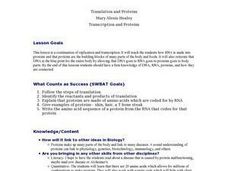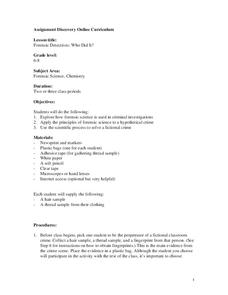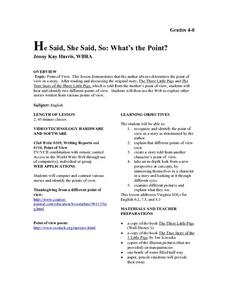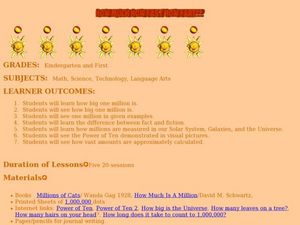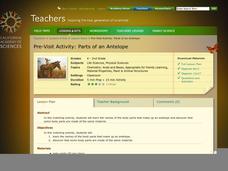Curated OER
Translation and Proteins
Learners follow the steps of translation and identify the reactants and products of translation. They able to explain that proteins are made of amino acids which are coded for by RNA. Students are able to give examples of proteins--...
Illustrative Mathematics
Counting Overview
Develop automatic, meaningful counting skills with your class by using everyday classroom/school items, objects, and opportunities. Counting skills should be practiced during the year using objects and items they are familiar with and...
Curated OER
How Can We Extract Human DNA?
Students perform an experiment in which they extract DNA samples from hair samples. They follow a set procedure to extract the DNA and complete summary questions.
Curated OER
Forensic Detectives: Who Did It?
Students explore forensic science and its uses in criminal investigations. They solve a fictional crime by identifying and analyzing the fingerprints, strand of hair, and thread samples for evidence. After completing charts for each,...
Curated OER
I love My Hair
Learners explore strategies to help focus on writing a personal narrative. In this personal narrative writing lesson, students read a book and discuss how the author lets readers know how they feel. Learners find a moment in their own...
Curated OER
Where Did That Curly Hair Come From?
Students pronounce (as best as they can) the scientific term used in explaining heredity. They study the meaning and/or significance of these genetic terms and use these words in sentences relating to the information taught in the unit.
Curated OER
Warm-up #7b -- Hair Raising!
In this reasoning worksheet, students use deductive reasoning to determine which people purchased a haircare item. They complete and record 7 steps to find the answer.
Curated OER
Dirt Babies
Dirt babies are an excellent way to show young botanists the plant life cycle. They explore the functions and industry behind grasses before growing some of their own. Use the informational text here and consider implementing some...
Rochester Institute of Technology
Artificial Hearing
Your sense of hearing depends upon tiny hairs deep inside your ear and if you lose these hairs, you lose your hearing. Here, groups explore hearing through the decibel measurement of common sounds. As a class, participants discuss...
Curated OER
Folktales of Zora Neale Hurston
Do you know why woodpeckers have red heads? Why the possum has no hair on its tail? Why a cat has nine lives? Find out by downloading this resource that uses Zora Neale Hurston's collection Mules and Men as the basis of a study of...
Curated OER
He Said, She Said, So: What's the Point?
Not by the hair on my chinny chin chin! Upper graders and middle schoolers read the story The Three Little Pigs and other tales related to the story from various points of view. They use the Internet to find more stories from...
Curated OER
How Much, How Fast, How Far?
Young scholars investigate the concept of the number one million. In this number concepts lesson, students read the book How Much is a Million? and brainstorm questions, such as "how many leaves are on a tree" and "how many hairs are on...
Curated OER
-air Spelling Pattern
What do hair, chair, and fair all have in common? The -air spelling pattern! Each slide provides both an image and a word that contains the -air sound. Perfect for early readers or to boost spelling success.
Curated OER
Long, Longer, Longest
This worm might be long, but can scholars draw an even longer worm? Focus on relative size as they draw a longer worm and then a longer necklace. Next, youngsters examine two sets of objects and check off the longest in an introduction...
Curated OER
La Tête
How do you say tongue in French? Hair? Learn vocabulary for all of the facial features. The first page has each vocabulary word and its illustration, while the second requires learners to label parts of the face. Then, they complete a...
Curated OER
Parts of the Face
Manipulate the components of a face, and learn the Spanish words for eye, nose, mouth, ear, hair, teeth, tongue, and eyebrow! After your beginning Spanish pupils design a face, have them pair up and practice naming the parts of the face.
Curated OER
Il est comment? Elle est comment?
Est-ce qu'elle petite ou grande? Review basic French descriptors with your beginning language learners. Nineteen slides review common phrases to describe one's physical shape and size, along with one's hair and eye color. The six final...
California Academy of Science
Parts of an Antelope
There are so many wonderful parts to an animal: fur, antlers, tails, and legs, to name a few. A large diagram of an antelope is used to start a matching game, where the class matches body parts made of the same material. They discuss...
Scholastic
Study Jams! Electricity
Shock your physical science class using this video to teach the basics of static electricity. Electricity is defined,and electrons are differentiated from protons on an atom model. The use of hydropower and wind are explained as ways of...
NASA
Building for Hurricanes: Engineering Design Challenge
"By the hair on your chinny-chin-chin, I'll huff and I'll puff and I'll blow your house in," says the big, bad wolf! Engineering hopefuls are challenged to design and construct a hurricane-proof building from simple office and craft...
Laura Candler
Time Capsule
It's amazing how much kids change from the beginning of the year to the end. Create a written account of their growth with a fun worksheet that involves children recording information about themselves at two points during the school...
Curated OER
The Rumpelstiltskin Story
Why didn't Rapunzel's hair stop growing? Why did it take the fairy godmother so long to intervene in Cinderella's affairs? Young writers consider unanswered questions like these and compose news articles investigating the true story...
Itsy Bitsy Fun
Reading Comprehension Worksheet
Practice color words and following instructions with a set of worksheets. Kids read each description on the side of the page about a person's hair color and clothing colors, and color the parts of the illustration accordingly.
Do2Learn
Personal Care
Help class members maintain their personal hygiene with a collection of instructive picture cards. Each card includes an image of someone taking care of his or her body, including brushing their teeth, combing their hair, or washing...
Other popular searches
- Coloring Hair
- Basic Haircutting
- Hair Analysis
- Hair Care Products
- Hair Care
- Hairy Bear Joy Cowley
- Hairdressing
- Aesthetics Hair
- Long Haired Girl
- I Love My Hair
- Hair Colors
- Coloring Hair Cosmetology


